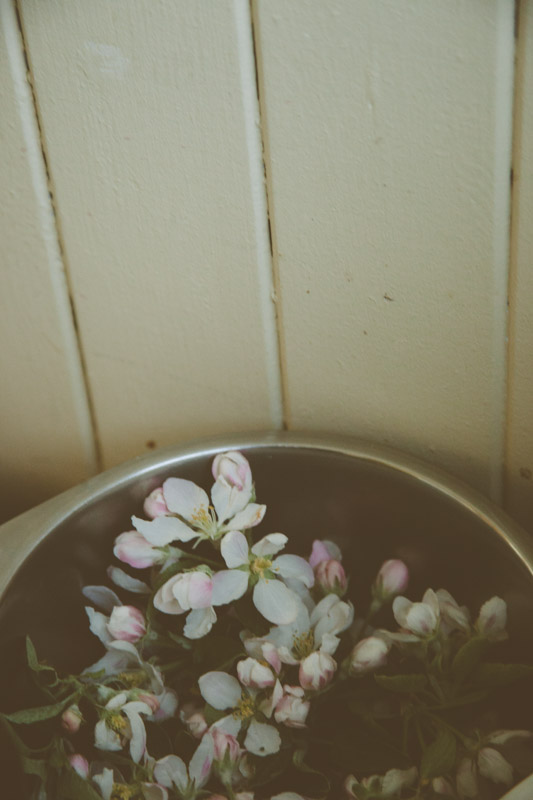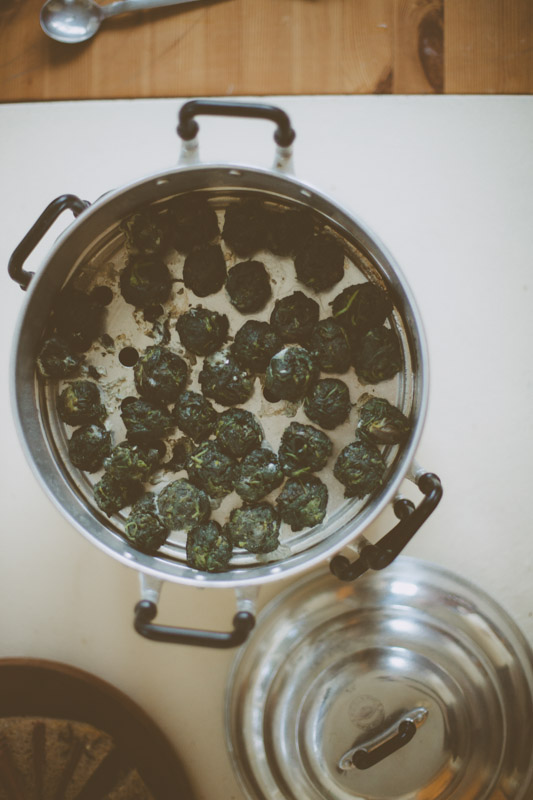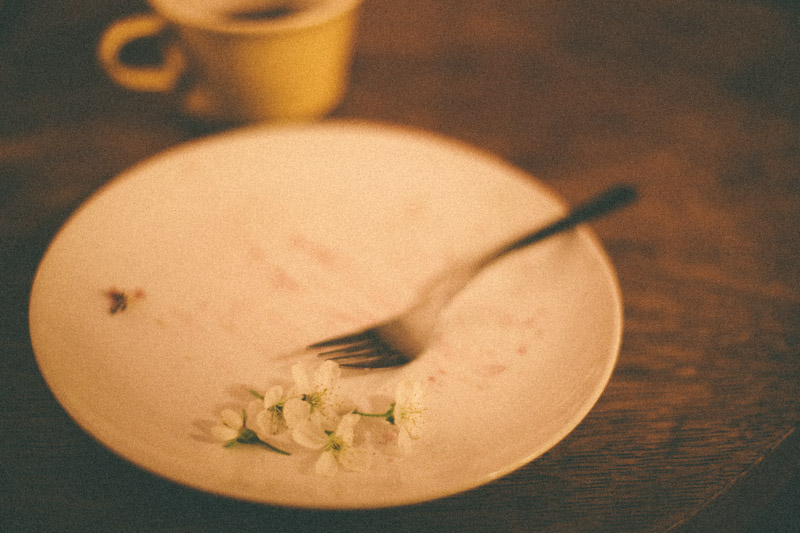spring is like perhaps a hand
(early april. number 48.)
III
Spring is like a perhaps hand (which comes carefully out of Nowhere)arranging a window,into which people look(while people stare arranging and changing placing carefully there a strange thing and a known thing here)and changing everything carefully spring is like a perhaps Hand in a window (carefully to and fro moving New and Old things,while people stare carefully moving a perhaps fraction of flower here placing an inch of air there)and without breaking anything. (e.e. cummings)
We celebrate the anniversary of this project's beginnings every New Year's Eve, but the first 'official' Secret Restaurant Portland event was in April of 2010, just a few weeks after the Farmer's Market had re-opened. It was Lucas and my first time living in Portland in the spring, and our introduction to numerous ingredients which have now become favorites.
We used sorrel and spring turnips, arugula roquette and watercress. We saw for the first time the abundance of otherwise unavailable, out-of-fashion or wildcrafted ingredients. The following spring, with a year of experience under our belts, we used morel mushrooms and purple sprouting broccoli among other spring delicacies we were previously oblivious to. The next spring we began wildcrafting our own nettles and made, I believe, nettle soup AND nettle pasta. Last year, we took the nettle thing really far and made green lasagna with nettle pasta, nettle cream sauce, nettle ricotta, and nettle pesto. Here are some quick links to past April events: #38, #29, #17, #1
Intending to scale back, upon remembering that very first year, the menu for this dinner designed itself. I visited the market one week before, purchased a few ingredients to experiment with during the week, and we all met briefly to throw around ideas and opinions. The poem above provided the last bits inspiration. In the early two thousands, I typed this poem onto an old postcard and mailed it to my first girlfriend Ha! I still find it compelling.
Fraction of flower // inch of air.
It should be noted that this dinner was the first this year to feature produce grown by us; mostly herbs, arugula, and rhubarb. As ever, home grown produce is notated with (S.G.) for 'Secret Garden.'
It's high-time to point out Kaaren Ponto, who can be seen with Lucas in the first photo on the forth row from the bottom. She has offered exceptional, swift, one might even say "badass" help with our last several dinners, stepping in right at the time we most need it.
Also, a special shout out to Bryan Taylor Markhart, who collaborated with Sofie in college on ambitious agricultural and food systems projects, and was visiting for many weeks surrounding this dinner. His image (6 rows down, middle) marks the first time we have a photograph of a sexy, hip ponytail on a man at one of our dinners. Whew- about time!
1:
Crackers & Things
• Blue cheese fife crackers with poppy seeds (a little spicy, complex with whole grain interest. The fife flour from the wonderful Tabor Bread.)
• Semolina crispbreads (wafer-thin, nutty and pleasing to eat. Sofie took the lead on the crackers!)
• Anchovy/garlic/paprika butter (As awesome as it sounds, if you like these things; excellent with the crisp breads.)
• Popcorn shoots (from that fun micro greens stand at market. Strong, sweet, unusual, compelling flavor.)
• Pickled dandelion buds (my take on a recipe suggested by Aria Mikkola-Sears, who has contributed frequently to this project and now works at the amazing Portland Apothecary.)
• Green Almonds (delicate, lovely flavor. Thanks World Foods!)
2:
Nettle Dumplings in Sorrel Broth
Wild-crafted nettles, the inclusion of which is dictated by April Secret Restaurant tradition. This time Lucas harvested on his dinner-hour lunch break, in the place we usually go, which just so happens to be near the fancy science factory where he works.
These were inspired by two separate times eating nettle dumplings made by Kevin Gibson, first at Evoe and then at Davenport. Having seen no recipes for such a thing, this was my best guess as to how they might be done. The nettle leaves were blanched, squeezed, chopped, mixed with egg, black pepper pecorino, more black pepper and flaky salt, formed into dumplings, then steamed on our chinese steam-bun rack steamer.
The broth was a revisitation of something we'd done for the very first official Secret Restaurant Portland event, four years ago. A roasted vegetable broth; carrots, turnips, onions, and parsley. Strips of sorrel leaves dropped in at the end, lifting the soup with its lemony zing.
3:
Spring Turnip & Calçot Tart, Slightly Wild Salad
Mild white harukei turnips are a favorite spring ingredient of mine. I have strived, through this project, to showcase this lovely vegetable.
The week before this dinner, I went to Portland Farmer's Market to wander the stalls and find inspiration for dishes we might do in whatever I found. First stop, often, is Veridian Farms, who specialize in small quantities of european, heirloom varieties of interesting produce. They had calçots, a spring onion traditionally grown in Catelonia (autonomous community in Spain). This is the onion traditionally used grilled, whole, and dredged through romesco sauce (we did this with more common spring onions in dinner #40).
I bought a bundle and used them all week; on sandwiches with tinned fish, with asparagus and goat cheese on pasta, folded into an herb omelette, and a practice tart very much like the one we ended up with. The pasta dish used Cana De Oveja, a spanish goat's cheese I've long loved for its versatility, affordability, and classiness. When it came time to devise the tart, this cheese was a natural choice.
Keeping it simple, the tart was as follows: Herb crust– sage, as it pairs so well with butter (and so do the turnips). Turnips– boiled, cooled, sliced, delicately sautéed in butter. Calçons– cut small and grilled on a hot cast iron till tender and caramelized in parts. The spanish goat's cheese– crumbled and mixed with labneh (middle eastern yogurt cheese). The vegetables and cheese tossed together, dropped into prepared tins, then topped with a single new sage leaf, which crisped up during baking. They were garnished with rosemary flowers (S.G.) and to a add some funkiness to a very precious dish, one small morel mushroom, piped full of the labneh/goat cheese, and deep fried.
A spring wreath of a salad was made around the tarts, including: green frilly lettuce, watercress, wild arugula roquette (S.G.),, sylvetta arugula (S.G.), and apple blossoms (S.G.). These were dressed with a lemon/lovage dressing, and an additional drizzle of grassy spanish olive oil and fleur de sel.
4:
Olive Oil Cake With Rhubarb & Flowers
A classic olive oil/lemon cake for fresh fruit, which Sofie has made many times. We did it with hibiscus flowers and rhubarb (S.G.). It was dusted with hibiscus powdered sugar and served with a dollop of Chartreuse whipped cream and cherry blossoms. Yes, we whipped cream with Elixer Végétal de la Grande-Chartreuse, the one that is green, has 130 herbs in it, is 69%, sold in little wooden bottles in very few places. Lucas knows how to find these things.
To drink:
Hernando De Soto- The Cocktail
Yes, I admit its a trifle odd naming our cocktail after a Conquistador, and we promise not to make a habit of it. A detail of my life sometimes mentioned in these pages, but often forgotten, is that by day I am preschool teacher. In one of my favorite picture books, Pigaroons by Arthur Geisert, a group of anthropomorphic pigs carve an ice sculpture of Hernando De Soto, which is later destroyed by an ice magnifying glass using the sun to melt it. The only explanation for Hernando's appearance would be that the story takes place on 'Spanish Ridge.'
We had this whiskey from Rogue Distillery, donated by my family friends who had won it through the Willamette Week Give Guide, or something. It is 'Dead Guy Whiskey,' aged briefly in the same barrels that produce their famed 'Dead Guy Ale.' Hernando De Soto is a dead guy, so there's one thing.
Additionally, we decided to do a take on a mint julep, because the family friends had warned us that the whiskey doesn't mix well with other boozes, so we wanted to keep it super simple. Having a bottle of the whiskey around on garden days, it had only been sampled on the rocks with a tiny splash of ginger syrup. Since that was good, I figured that a julep with ginger syrup instead of simple syrup would work just fine.
We love herbaceous drinks, and experimenting with unusual ingredients, so when we came upon lovage at the mushroom stand at farmer's market, heard the mushroom guy's story of how popular it is in Romania, then tasted its celery-meets-cardamom qualities, we had our mint replacement. This 3-part incarnation of the drink was good, but lacking something. I read up on the origins of the mint julep, and amongst staggering figures about how many are consumed every year during southern horse races, was revealed that the word julep derives from the Persian word گلاب (Golâb), meaning rose water. Suddenly the pieces came together: rose water/ginger/cardamom. The rosewater lifting it in just the right way. Lovage, favored by the Romanians, the last 'western' country in Eastern Europe.
None of these things have anything to do with Spain or Conquistadores. Then I read up on Hernando De Soto. He was the first documented explorer to travel west of the Mississippi, and in 1540/1541, occupied most of the modern southern states; future mint julep territory.
Water Avenue Ethiopia Yirgacheffe
Our friend Aaron Baker has been pairing coffee's for us for over a year now, flawlessly every time. This one couldn't have been better with the rhubarb cake and liqueur whipped cream. As he put it when I came to pick up the bag (I paraphrase): "The coffees in Ethiopia are the most diverse in the world, that's where it all began. So you nearly always end up with something complex yet totally elegant and simple."
From the bag: The profile of a washed Yirgacheffe is a classic, with tea-like notes and floral nose. The body is delicate yet full of caramel sweetness, chocolate, and bright citrus. This is the acme of a well balanced Eithiopian heirloom varietal. Try it as a pour-over to enhance the floral aroma.
We did standard pour over, chemex, and french press to maximize the 'make coffee for nearly 20 people' situation.
The guests also brought many lovely wines.







































